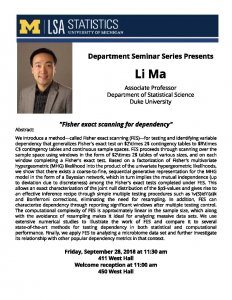Presented By: Department of Statistics Seminar Series
Statistics Department Seminar Series: Li Ma, Associate Professor, Department of Statistical Science, Duke University
Fisher exact scanning for dependency

We introduce a method---called Fisher exact scanning (FES)---for testing and identifying variable dependency that generalizes Fisher's exact test on $2\times 2$ contingency tables to $R\times C$ contingency tables and continuous sample spaces. FES proceeds through scanning over the sample space using windows in the form of $2\times 2$ tables of various sizes, and on each window completing a Fisher's exact test. Based on a factorization of Fisher's multivariate hypergeometric (MHG) likelihood into the product of the univariate hypergeometric likelihoods, we show that there exists a coarse-to-fine, sequential generative representation for the MHG model in the form of a Bayesian network, which in turn implies the mutual independence (up to deviation due to discreteness) among the Fisher's exact tests completed under FES. This allows an exact characterization of the joint null distribution of the $p$-values and gives rise to an effective inference recipe through simple multiple testing procedures such as \v{S}id\'{a}k and Bonferroni corrections, eliminating the need for resampling. In addition, FES can characterize dependency through reporting significant windows after multiple testing control. The computational complexity of FES is approximately linear in the sample size, which along with the avoidance of resampling makes it ideal for analyzing massive data sets. We use extensive numerical studies to illustrate the work of FES and compare it to several state-of-the-art methods for testing dependency in both statistical and computational performance. Finally, we apply FES to analyzing a microbiome data set and further investigate its relationship with other popular dependency metrics in that context.